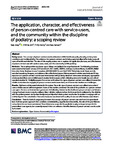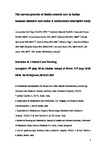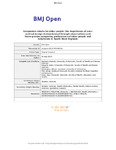The application, character, and effectiveness of person-centred care with service-users, and the community within the discipline of podiatry: a scoping review
| dc.contributor.author | Abey, S | |
| dc.contributor.author | Anil, K | |
| dc.contributor.author | Hendy, P | |
| dc.contributor.author | Demain, S | |
| dc.date.accessioned | 2022-10-27T14:09:34Z | |
| dc.date.issued | 2022-08-19 | |
| dc.identifier.issn | 1757-1146 | |
| dc.identifier.issn | 1757-1146 | |
| dc.identifier.other | 63 | |
| dc.identifier.uri | http://hdl.handle.net/10026.1/19764 | |
| dc.description.abstract |
Background The concept of person-centred care is embedded within healthcare policy, focusing on long-term conditions and multimorbidity. The evidence that person-centred care is being operationalised effectively across all areas of healthcare is limited. The aim of this scoping review was to explore the application, features, and effectiveness of person-centred care with service-users, carers, and the community within podiatry. Methods The scoping review was based upon Arksey and Malley’s five stage framework. The following databases were searched between January 2010 and March 2021: AMED, CINAHL, Embase, Cochrane library, SocINDEX, British Education Index, Business Source Complete, MEDLINE (EBSCO), and the EThOS 'Global electronic thesis and dissertation' repository, Prospero, and reference lists of included papers. Primary research articles were included if they reported on a person-centred care focused intervention with podiatry. Research terms were developed, appropriate databases identified, and an initial search resulted in 622 papers which, following removal of duplicates and critical appraisal, resulted in 18 eligible papers. Data extracted involved the types of person-centred care utilised, intervention details, motivations for engaging in person-centred care interventions, and intervention barriers and challenges. Results Eighteen articles were included in the review. The main type of person-centred care utilised was patient/carer activities around self-management. None of the studies considered the role of the podiatrist as a person-centred care agent. The data on interventions generated the following themes ‘service facilitated person-centred care’ where a change has been made to service delivery, ‘direct clinician delivery’ where the intervention is delivered by the clinician with the patient present and ‘patient instigated participation’ where patient motivation is required to engage with an activity beyond the consultation. Outcome measures associated with quality of care and effectiveness were absent. Conclusion There is a lack of congruency between the concept of person-centred care and how it is operationalised. A whole system approach that considers commissioning, organisational leadership, the role of the practitioners and patients has not been considered. There is immense scope for the podiatrist to play an important part in the personalised-care agenda, but currently research that can evidence the effectiveness of person-centred care in podiatry is absent. Review registration Open Science Framework (osf.io/egjsd). | |
| dc.format.extent | 63- | |
| dc.format.medium | Electronic | |
| dc.language | en | |
| dc.language.iso | eng | |
| dc.publisher | BioMed Central | |
| dc.subject | Scoping review | |
| dc.subject | Podiatry | |
| dc.subject | Patient-centred care | |
| dc.subject | Patient centred-approach | |
| dc.subject | Person-centred care | |
| dc.subject | Person-centred approach | |
| dc.title | The application, character, and effectiveness of person-centred care with service-users, and the community within the discipline of podiatry: a scoping review | |
| dc.type | journal-article | |
| dc.type | Review | |
| plymouth.author-url | https://www.ncbi.nlm.nih.gov/pubmed/35986405 | |
| plymouth.issue | 1 | |
| plymouth.volume | 15 | |
| plymouth.publication-status | Published | |
| plymouth.journal | Journal of Foot and Ankle Research | |
| dc.identifier.doi | 10.1186/s13047-022-00566-z | |
| plymouth.organisational-group | /Plymouth | |
| plymouth.organisational-group | /Plymouth/Faculty of Health | |
| plymouth.organisational-group | /Plymouth/Faculty of Health/School of Health Professions | |
| plymouth.organisational-group | /Plymouth/REF 2021 Researchers by UoA | |
| plymouth.organisational-group | /Plymouth/REF 2021 Researchers by UoA/UoA03 Allied Health Professions, Dentistry, Nursing and Pharmacy | |
| plymouth.organisational-group | /Plymouth/Users by role | |
| plymouth.organisational-group | /Plymouth/Users by role/Academics | |
| dc.publisher.place | England | |
| dcterms.dateAccepted | 2022-08-02 | |
| dc.rights.embargodate | 2022-10-29 | |
| dc.identifier.eissn | 1757-1146 | |
| dc.rights.embargoperiod | Not known | |
| rioxxterms.versionofrecord | 10.1186/s13047-022-00566-z | |
| rioxxterms.licenseref.uri | http://www.rioxx.net/licenses/all-rights-reserved | |
| rioxxterms.licenseref.startdate | 2022-08-19 | |
| rioxxterms.type | Journal Article/Review |




